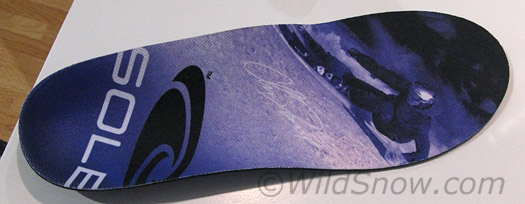I walked on top of Ed Viesturs during our Denali trip, but I think Chris will be better for that because he’s thinner.
No, not the guys. Rather, I’m talking about Ed and Dav’s signature insoles from Sole footbeds. Dav’s model is based on Sole’s Thinsport version, which is perfect for fitting in ski boots that you’ve sized conventionally.

Chris Davenport footbed from Sole.
On Denali we went oversized with our boots and used the thicker Viesturs signature model. For that we had to upsize one shell size. Either way, thick or thin, in my opinion Sole is the best aftermarket footbed you can get this side of hiring a professional boot fitter. They take a very small amount of heat molding if your foot shape requires, but can also be used out of the box as a nice supportive foundation for your wheels.
Dav’s model includes a laminated layer of heat reflective material. During testing of such radiant barriers last winter (with other footbeds, not Sole) I remain unconvinced this type of thing really yields anything more than a minuscule increase in warmth, and even that might be psychological.
But a layer of aluminum foil (or whatever) really weighs nothing, so I’ll continue to give it the benefit of the doubt. My testing was done by wearing the reflective stuff on one foot and not on the other. Not the most scientific, but I think after a dozen days of doing that one should be able to get a pretty good sense of what works and what does not.
Your thoughts WildSnow readers? Can a reflective radiant barrier really do much when it’s sandwiched in between plastic and foam layers in a boot footbed?
WildSnow.com publisher emeritus and founder Lou (Louis Dawson) has a 50+ years career in climbing, backcountry skiing and ski mountaineering. He was the first person in history to ski down all 54 Colorado 14,000-foot peaks, has authored numerous books about about backcountry skiing, and has skied from the summit of Denali in Alaska, North America’s highest mountain.
